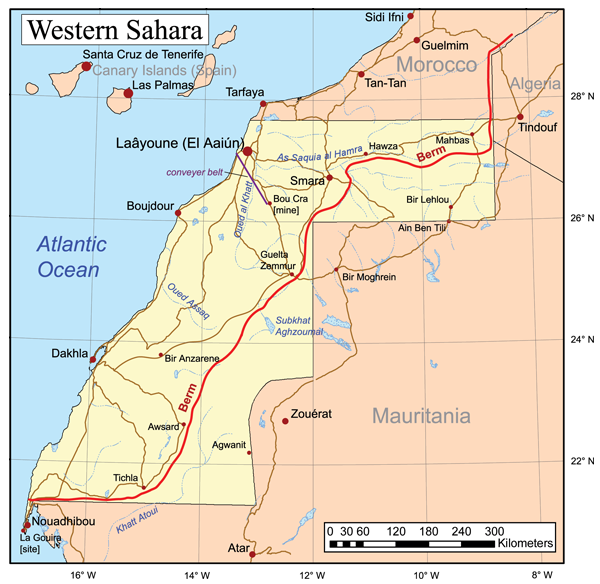*Image Credit: Wikimedia Commons On the northwest coast of Africa, a unique demonstration against European colonialism took place on November 6, 1975: 350,000 people gathered near the border of their home country, Morocco, to walk peacefully into the Spanish-occupied territory to the south. The Green March, so named for the color associated with Islam, was a coordinated attempt by the Moroccan leadership to reclaim Western Sahara, which had been annexed by Spain in 1884. Opposition to the presence of European administration in the Spanish Province of Sahara gained momentum during the 1950s. The Polisario Front, a Socialist organization formed by Sahrawi natives hoping to turn their homeland into an independent nation, grew out of the discontent. Taking up arms in a guerilla campaign against the Spanish governors in 1973, the group came together with the express purpose of driving out European influences to achieve sovereignty for Western Sahara. Frustrated with the security threats by October 1975, representatives from Spain secretly began discussions for an orderly transfer of power to the Sahrawi. There was just one problem: leadership in other countries was convinced of having ownership of the area, as well. Mauritania, neighboring to the south and east, believed it had some rights to the province. Morocco, to the north, felt it had even stronger historical ties, appealing to the International Court for Justice (ICJ) at The Hague, Netherlands for a ruling. On October 16th, the parties received word the ICJ concluded both the Moroccans and Mauritanians had connections to the region in question. On the other hand, since these cultural exchanges were nearly non-existent by the time the Spanish arrived, the tribunal sided with the Sahrawi right to determine their own course — whether that included maintaining the status quo, joining another country or forming a nation of their own would be up to them. King Hassan II of Morocco, ignoring the latter call for self-determination, soon announced plans to “reunite [Western Sahara] with the Motherland.” Two weeks later, he ordered his army to push into the territory — and the Polisario were there to greet them. Fierce fighting ensued, with the Spanish Armed Forces an interested spectator. A week later, on November 6, 1975, some 350,000 Moroccans gathered in the coastal town of Tarfaya, just a little more than 20 miles from the Western Sahara border. Once flanked by 20,000 soldiers, the Green March began with unarmed civilians waving flags and carrying banners toward their “brethren” to the south. Spanish troops, for their part, followed orders to stand down, going so far as to remove mines from the area in order to avoid an unnecessary catastrophe. With the Spanish government in crisis as Generalissimo Francisco Franco lay dying, an emergency meeting was called for the following week, with the Moroccans shrewdly demanding for the Sahrawi to be left out. The Madrid Accords, announced on November 14th, would allow Morocco and Mauritania to regain parts of Western Sahara while the Spanish held onto a portion of their commercial interests in the region. The Polisario were furious. Rejecting the agreement, the group solicited Algeria for military aid, stepping up operations against the Moroccan military in early December. Fighting for another 16 years, the two sides finally agreed to a cease-fire on September 6, 1991 with the Sahrawi demanding a referendum would be held on independence within twelve months. More than two decades later, the vote has still not occurred. Also On This Day: 1893 – Russian composer Pyotr Ilych Tchiakovsky dies 1913 – Mohandas Gandhi is arrested in South Africa leading a march of Indian miners 1935 – Board game manufacturer Parker Brothers acquires the patents to Monopoly 1944 – The Hanford Atomic Facility, part of the United States’ Manhattan Project, produces plutonium for the first time at its lab in Hanford, Washington 1962 – The United Nations General Assembly condemns apartheid calls for members to cut relations with South Africa
November 6 1975 CE – The Green March Sends 350,000 Moroccans into Western Sahara
*Image Credit: Wikimedia Commons On the northwest coast of Africa, a unique demonstration against European colonialism took place on November 6, 1975: 350,000 people gathered near the border of their…
455
